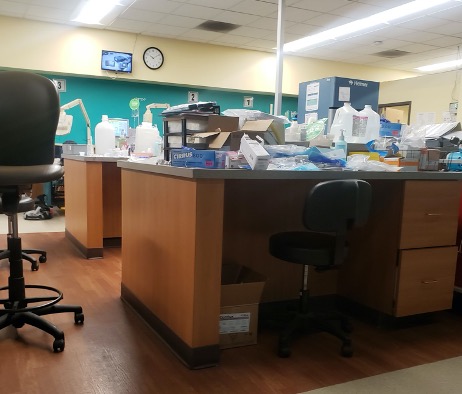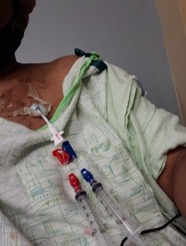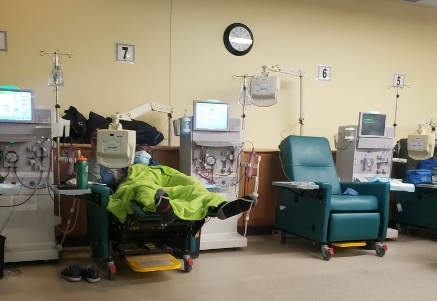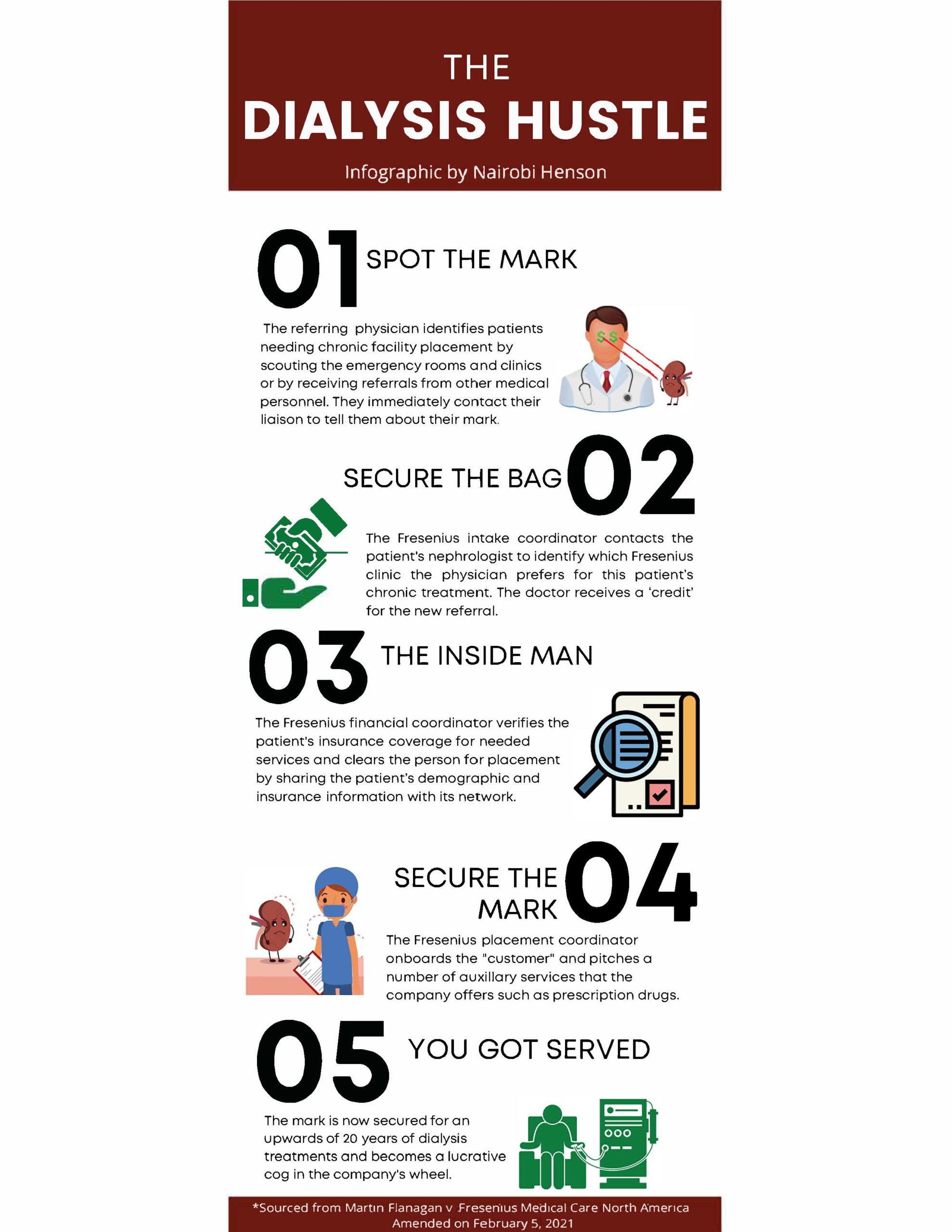(Published in print May 15, 2021)
INVESTIGATIVE REPORT
The Crusader Takes A CLOSER LOOK
Part II of a IV Part Series
A Survivor’s Story
This COVID-19 survival story reminds me of the time my cat, Sheba, was caught in my knitting basket unravelling a big red ball of yarn. The more I pulled at the strings, the more tangled of a tangled mess it became.
On February 12, I was three hours and forty minutes into a hemodialysis treatment at Neomedica Fresenius South Shore, 2420 E. 79th St., when the chest catheter attached to a dialysis machine exploded and dislodged, sending a spray of blood into the air, like a scene in a Quentin Tarantino movie.
As noted in part one of this series, while being treated in South Shore Hospital’s emergency room care for coronavirus-induced pneumonia, I was told my kidneys were failing and I needed to be placed on dialysis. I was whisked off to surgery before a Dr. Woo told me to prepare for up to 20 years on dialysis, if I didn’t get a kidney transplant or die first.
After several weeks of dialysis, my personal physician asked that I transfer to nephrology services at Northwestern Hospital so she could coordinate my care.
Like I said, this is a ball of yarn. The story is complicated. So, in the interest of time, just understand I had not been under my doctor’s care when COVID erupted, and what I learned was Acute Kidney Injury (AKI) happened to me. I had solely relied on the expertise of the physicians I met during my COVID fight.
AKI is the sudden loss of kidney function. With proper treatment, including dialysis in severe cases, it can be reversible. At South Shore hospital or the unaffiliated dialysis clinic, I was never told by anyone that what I had might be temporary.
However, after being treated at Northwestern for several days after the catheter exploded, the nephrology team there was happy to tell me I was not in end stage renal failure at all—and that what I had experienced appeared to be AKI. I no longer required dialysis.
After the elation wore off, it was not lost on me that I had only gotten my good news because of a freak accident. [To date, no one has explained how that catheter dislodged or why. One physician told me it was probably a “miracle” and that I was “lucky” that I wasn’t killed in the process.]
How could this happen, I wondered? What would have happened to me if this thing had never come out—would I have been on dialysis for half a decade waiting for a possible transplant or worse? Were there any other people with AKI who were placed on permanent dialysis? Is this why there appears to be a proliferation of dialysis centers on the South and West sides?
The depositions taken in a slew of federal lawsuits against Fresenius Medical Care North America (FMCNA) and other dialysis centers, offer a shocking glimpse into how these companies recruit both physicians and their patients to its global network. One person described a system all too familiar to the descendants of enslaved people.
“Fresenius’ various schemes, … treated patients as chattel who could be directed to treatment options that were the most lucrative for it financially,” one whistleblower lawsuit said.
For more than 233 years, slaveholders turned human beings into property—people who were priced, bought, sold and forced to work without wages or suffer the consequences of bodily harm or death. And, now here I was apparently another cog in somebody’s wheel.
I thought about the slew of medical experimentations on Black people; the infamous Tuskegee experiment in the 20th Century and the forced sterilization of African-American women, some of whom were given unneeded hysterectomies. I knew that kidney disease was common among my people, but why? Was all of it attributable to heritage, diet and social environment? How many have prematurely been put on dialysis?
MECHANICS OF THE HUSTLE
“You can earn a great deal of money—often much more than $100,000 annually—for little or no investment of time. In exchange, all you have to do is refer your patients to our clinics,” read the pitch to physicians according to the lawsuit filed against FMCNA.
A Crusader analysis revealed that most of the medical directors of Fresenius’ clinics on Chicago’s South Side are Asian Americans of East Indian heritage. In a federal lawsuit, it was revealed that the pay for many Illinois Fresenius medical directors is far above the average nephrology hourly rate of $147 per hour.
The 17 highest paid medical directors in Illinois were part of the Nephrology Associates of Northern Illinois and Indiana (NANI), 120 W. 22nd St., Oak Brook, IL. Physicians earned over $200,000 annually for hourly billings of $421 per hour to $1,196 per hour.
NANI is reportedly the largest nephrology practice in the U.S. with over 120 kidney specialists in three states. Of the top Fresenius medical director salaries paid in Illinois, the NANI medical directors are among the highest, according to [Martin] Flanagan’s lawsuit. Dr. Arthur Morris, president of NANI and medical director at FKC West Suburban Dialysis Clinic in Oak Park, was paid $597,913.
Other highly paid doctors included the medical director of Fresenius Southside Dialysis, 3134 W. 76th St., Dr. Guatam Bhanushali who earned $430,161. The Greenwood Avenue clinic, 1111 E. 87th St., is headed by Dr. Malathia Shah who earned $279,439. At Jackson Park Hospital, a clinic at 7531 S. Stony Island Ave., is overseen by Dr. Wadah Atassi who earned $216,039. On the Northwest Side, Fresenius Neomedica, 4800 N. Kilpatrick Ave., is headed by Dr. Madhav Rao who earned $259,182.
Atassi and Shah are affiliated with South Shore Hospital where they are able to treat and manage patients, according to NANI’s corporate website. Dr. Clark McClurkin, who made rounds at Neomedica South Shore’s clinic, and Dr. Kareen Simpson, who was a physician at Symphony of Crestwood nursing home, where I was denied treatment and with whom I never spoke with, are in the same nephrology group, Associates in Nephrology (AIN).
According to their website, AIN has a staff of over 40 nephrologists, including Dr. Sumanth Mulamalla, who is listed as working at South Shore’s location. Headquartered at 210 S. Des Plaines St., it is headed by Dr. Amit Mitra and Dr. Chirag Patel. Though a smaller group, their medical directors cover multiple Fresenius clinics, which can be quite lucrative for the medical group.
McClurkin, who is Black and who was on call when the catheter exploded and dislodged from my chest on February 12, supervises or provides medical services at eight Fresenius clinics, including locations at South Shore, Roseland, South Chicago, Mokena, Blue Island, Alsip, Merrionette Park, and South Holland.
A Crusader analysis of market data estimates that the U.S. kidney dialysis industry was worth $24.7 billion in 2018, up 5.5 percent from 2017. The market is expected to reach $29.7 billion by 2023. That’s a lot of cheddar—and you aren’t even the mouse.
So what exactly was “the hustle” and at what point did I consider I was part of a long con?
The first clue was an interesting conversation I had with a district manager a day after I almost died during my first dialysis treatment. Something happened and my pressure dropped, I almost passed out, and I went temporarily blind. Two days later, I recovered, and was back for a second round.
Kevin Roberts, not his real name, was working as a dialysis technician the first week I received dialysis treatment at Fresenius Beverly Ridge, 9924 S. Vincennes Ave. Both welcoming and personable, he took mercy on me and time explaining how the equipment worked and what I might expect during treatment. He was so nice, I offered to write him a letter of commendation to his supervisor to place in his personnel records.
“I’m trying to move up in the company,” Roberts explained, after sharing his background in public health and his love for pit bulls. “They are very big on customer service—and making sure every customer is given the best service possible.”
“Customer?” I didn’t say anything to the young man since he was being so nice and candid and all. But, being called a ‘customer’ is the last thing I want to hear when the ‘service’ being provided is a matter of life-and-death.
“To be honest with you,” he added, “every clinic is different, and everybody won’t spend this kind of time with you. Overall, the nurse is a good person and you’re in good hands over there.”
At my home clinic, as they called it, I found everyone welcoming and professional. However, within minutes of arriving at Neomedica South Shore, I realized my care hadn’t been coordinated by Fresenius at all. I found myself having to explain over and over that I was new to dialysis, brought on by COVID and therefore was not clear on processes or what the future held.
For several weeks I sat in a large room filled with nearly 20 other people receiving the same life-saving care. Most were older African Americans, but the age range appeared broad. Patients mostly kept to themselves, but occasionally someone might crack a joke or cause a big enough stir that I and others would glance their way.
In once such instance, a woman had just been taken off the machine when blood started shooting out of her fistula.
I watched as the nurse and a technician scurried over to her as she kind of stood there watching her life force pool around her feet on the floor. They may have stopped her bleeding, but that did nothing to quiet the anxiety that had engulfed me like the yarn did my Sheba.
Each time a technician plugged me into the machine and started punching a code via a keypad, I could feel my heart rate increase. I was scared out of my mind. I had known relatives who had gone to dialysis only to never return home.
About a week before my malfunction, I watched a guy sitting in a chair next to me start urinating blood in a plastic container. The staff told him his treatment was over and that he needed to go to the emergency room to get himself checked out. I don’t know if he did. I never saw the guy again.
KICKBACK ALLEGATIONS
Martin Flanagan worked for Fresenius Medical Care North America (FMCNA) for 29 years. As its Western Division director of acute market development, he was responsible for negotiating contracts under which FMCNA provided dialysis treatment to hospital inpatients.
In March 2014, the Texas man turned whistleblower when he alleged Fresenius was engaged in an illegal kickback scheme with hospitals, physicians, social workers and other medical personnel. The goal was to secure patients for its clinics and to help it eliminate any competition. Therefore, Flanagan alleges, FMCNA was in violation of the False Claims Act and the Anti-Kickback Statute (AKS) 42 U.S.C. (1320a-7b(b).
The suit also alleges “Fresenius offered payment to nephrologists in exchange for referrals to FMCNA’s network of outpatient clinics” through lucrative medical director agreements. Unbeknownst to the patient, those contracts provided financial incentives and bonuses to doctors based on the number of people they discharged to the corporation’s centers for dialysis services.
In other words, while you’re thinking you’re getting the best care possible, based on medical advice, you’re really being “sold to the highest bidder,” in this case Fresenius, for profit. It is in the interest of those doctors, social workers and others, to sell you to the dialysis clinic that is offering the top dollar.
The Crusader reached out to Flanagan for comment, but through his attorney he declined.
However, Flanagan’s voice rings through his 147-page legal filing, “The (anti-kickback scheme) was intended to protect federal health care program beneficiaries from the corrupting influence of money on medical decision-making and referral decisions,” Flanagan said. “The statute is designed to guard federal health benefit programs from anti-competitive arrangements which reduce patient choice, resulting in overutilization, increased cost of services, and poor quality of care.”
The suit also alleged, Fresenius was guilty of defrauding the government because the practice of offering kickbacks to hospitals and referring physicians was designed to “induce the referral of services billed to a federal healthcare program.”
If Flanagan’s allegations are true, that could explain why South Shore Hospital’s social worker was unable to identify any other dialysis company in Chicago that may have also been able to provide me the so-called emergency care I needed. “Hospitals where Fresenius had an acute care contract reliably sent about 70 percent to 80 percent of the ERSD patients they discharged to Fresenius dialysis centers for outpatient treatment.”
The technician who provided me my first in-patient treatment was employed by Fresenius. And, it should be noted I do not have evidence of any such kickback scheme at South Shore Hospital. As an independent, non-profit hospital, it is not subject to Freedom of Information Act (FOIA) requests.
The Crusader also contacted South Shore Hospital to ask officials if any of its administrators or medical personnel have third-party contracts with Fresenius or any other dialysis center. The answer was not provided by the press deadline.
However, according to witness testimony in the 2014 case, “dialysis frequently begins when a patient ‘crashes and burns’ into the hospital,” requiring emergent treatment for kidney failure in the hospital’s emergency room and/or intensive care unit (“ICU”).
“That phone call from the ER drives the business for the nephrologist.”
As such, the ER and ICU became “hunting grounds” for nephrologist medical directors who wanted to boost their referrals and their compensation from Fresenius. These physicians would do rounds in the ER and ICU, even if they were not responsible for the care of any patients in those areas, attempting to identify patients with kidney failure who would require dialysis and direct their referral to Fresenius facilities.
A November 12, 2014, lawsuit filed by plaintiffs in New York made similar allegations. The CKD Project, a limited liability group formed for the purposes of the lawsuit, alleged Fresenius made “false and fraudulent statements, records and claims… in violation of the federal False Claims Act.
“Put bluntly, Fresenius paid for dialysis patient referrals and it did so handsomely,” wrote Attorney Geoffrey R. Kaiser, of Kaiser Law Firm PLLC in Uniondale, NY. “These agreements constituted egregious violations of the federal Anti-Kickback Statute and generated untold numbers of false claims submitted to the Medicare and Medicaid programs for which Fresenius wrongly received reimbursement.”
Kaiser also alleged, “Such claims cheated the government and unlawfully enriched Fresenius,” before calling for relief in damages. The lawsuit is proceeding in the U.S. District Court Eastern District of New York, along with separate lawsuits filed by other plaintiffs in Colorado, Hawaii. Texas, and Massachusetts..
In March 2019, The U.S. Department of Justice (DOJ) and the Securities Exchange Commission (SEC) announced Fresenius agreed to pay $231 million in criminal penalties to resolve Foreign Corrupt Practices Act (FCPA) in connection to a scheme to obtain business in multiple foreign countries.
Between 2007 and 2016, Fresenius paid bribes to publicly employed health and/or government officials to obtain or retain business in countries in West Africa, Angola, Saudi Arabia and Morocco. “Bribery in all forms is corrosive and illegal,” said U.S. Attorney Andrew Lelling at the time “…This office will continue its long tradition of aggressively investigating companies and individuals who use bribes and kickbacks to gain an unfair and illicit business advantage, or who deliberately turn a blind eye to that conduct.”
According to the Department of Justice, Fresenius engaged in corrupt conduct in 13 countries, yielded profits of more than $140 million and continued operating such agreements for an additional four years after such misconduct was brought to light.
In exchange for the multimillion dollar fine, the Non-Prosecution Agreement also called for an independent compliance monitor for a term of two years, followed by an additional year of self-reporting to the DOJ.
In July of last year, a SEC filing revealed Fresenius, along with DaVita, and other kidney drug manufacturers, was facing a lot of litigation, including investigations into its management of pharmaceuticals includ- ing Velphoro.
On April 8, 2019, United Healthcare served a demand for arbitration against Fresenius, saying the company “unlawfully steered patients by waiving co-payments and other means away from coverage under government funded insurance plans, including Medicare into United Healthcare’s commercial plans, including Affordable Care Act Exchange Plans.” A final hearing date has been scheduled in arbitration for August 23, 2021.

2420 E. 79th Street, as taken January 7th. (Photo courtesy Stephanie Gadlin)
THE HUSTLE EXPLAINED
Keeping it real. If reading a bunch of legal jargon isn’t your cup of tea, based on our findings here’s a breakdown of how the hustle works. It should be noted, while there is no evidence that this happened in my case, there’s no evidence that it didn’t happen either. Each step of the scheme is done without the patient’s knowledge or approval.
- First, the referring physician or hospital discharge planner (social worker, nurse, etc.) identifies patients needing chronic facility placement by scouting the emergency rooms and clinics or by receiving referrals from other medical personnel. They immediately contact their liaison to tell them about their mark.
- This referring doctor, who is usually part of a nephrology medical group, or hospital social worker, never discloses to the patient that he or she is being paid by a dialysis provider to secure patients for that company. No other option is presented to the patient.
- Second, the Fresenius intake coordinator contacts the patient’s medical doctor (or assigned nephrologist) to identify which Fresenius clinic the physician prefers for this patient’s chronic treatment. The doctor chooses the location—and that will more than likely be at a clinic where he/she can receive ‘credit’ for the new referral.
- Third, with the mark in check, the Fresenius financial coordinator verifies the patient’s insurance coverage for needed services and clears the person for placement by sharing the patient’s demographic and insurance information with its network.
- Step four: The Fresenius placement coordinator then educates the new patient through its “Treatment Options Program” and ensures the customer is enrolled in the Fresenius prescription drug service, which offers an array of kidney-related pharmaceuticals required by dialysis patients, such as vitamins and nutrition binders.
- In the final step, with the mark now secured in lifelong dialysis scheduled treatments, the company’s placement coordinator follows up with patients one week after placement to provide the new customer with a Fresenius-branded neon green blanket and a binder highlighting an array of services offered by Fresenius, including in-home dialysis systems touted by the company.

treatment to patients on dialysis. After this patient’s device suddenly
dislodged, she learned she did not need to be on dialysis
at all. (Photo courtesy Stephanie Gadlin)
By the time you’re plugged up to the machine, you are a significant part of a system you had no hand in selecting. You get the treatment you need and somebody else gets a cut. In my case, I didn’t know if Fresenius was the best option for me, or if there were alternatives to care, because none were provided—and to be honest, in the middle of a pandemic, I was more focused on trying to stay alive.
It’s sort of like a health care con job, except the patient’s life depends on the information you’re being told. Cons are situations in which a hustler builds trust, through deceit, in the pursuit of some benefit for the con artist and at a cost to the mark or victim. In my case, I felt like I was no longer a part of my medical care planning, that choice was taken away from me. Maybe that’s why at Fresenius you are referred to as a customer and not a patient.
When you are a customer, it only matters if you receive good service and whether or not a company or specialist did what was asked, like getting an oil change or installing home cable service. With services rendered, all you do is pay the bill.
As a customer you aren’t required to know the how, the why or the what. All you need to know is you got what you paid for.
Being a patient requires physicians and providers to collaborate with the patient to ensure the person’s best health outcome. The former example recognizes your wallet, the latter acknowledges your humanity.
The commodification of Black bodies continues. There are laws in place to protect people from direct harm that healthcare can sometimes cause. However, medical malpractice claims are expensive and extremely hard to litigate, or so I have been told. Typically patients are required to sign lengthy legal contracts with hospitals, pro- viders and individuals offering in-home health care services.
These “patient rights” are designed to trick you into thinking you’re in control when its true design is to absolve the provider of any negligence pertaining to your care. In short, the one I was required to sign at Fresenius basically says if anything happens to me while receiving dialysis in their center, I am “SOL (out of luck).”
I was required to sign these contracts at both Fresenius’ clinics. In the “FMCNA Patient Rights,” there I realized that if I was going to receive the life-support services I was told I needed, then I’d have to be in compliance with their intake process. Though their documents say all of the right things, the way it was implemented in the clinic was not my experience.
But what about the indirect harm caused by hidden variables beyond the patient’s control?
Who stands up for people like me?
UP NEXT: Consumer Protection & Dialysis
Researcher Nairobi Henson and reporter Shaya Simmons contribut- ed to this reporting. This series was made possible by a grant from The Field Foundation of Illinois, Inc. and support of MuckRock, an investigative journalism resource.







